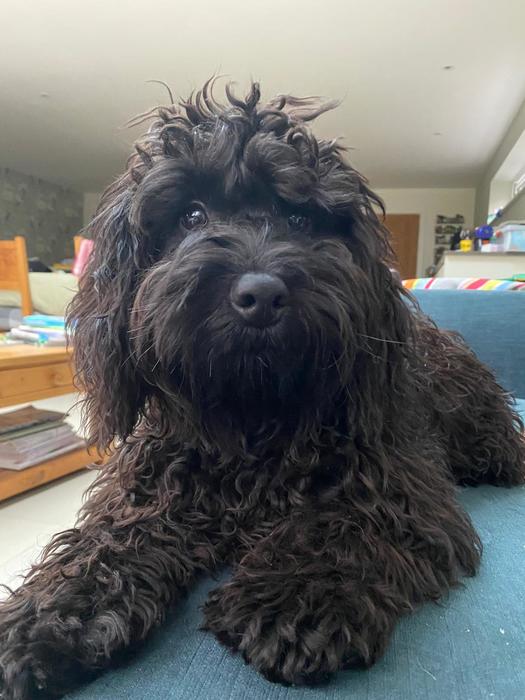Meet Ruby: separation training for a cockapoo puppy
admin2021-03-12T09:21:58+00:00I had the best news today, little Ruby the cockapoo aced 45 minutes of alone time! Hands down the best bit of my job is hearing about the wonderful successes, the fruits of all the hard work my clients put in, and Ruby is no exception. Both Ruby and Karen really deserve their win!
I wanted to write a bit about Ruby’s separation training, as she is a perfect example of how separation training can help young dogs learn to feel relaxed when left alone, and develop desirable behaviours along with it! Yes, it takes some work but the long-term benefits are immeasurable.
Cockapoos are not the easiest dogs to separation train. This adorable mix of cocker spaniel and poodle makes for a highly sociable dog, and like many of our pet dog breeds and mixes they are happiest when with their special human! They are quite quick to “speak up” (bark!) if they don’t like something too, and it can be tricky to tell the difference between a tantrum and a panic attack.
At the start of our training, 5 month old Ruby could only really hold it together for a few seconds before she would bark in an attempt to get her owner to come back through the door. Ruby’s owner Karen had already trained her to sleep alone in her crate, however leaving her alone in a room during the daytime was another story. Karen was yet to try leaving the house.
After 8 weeks working together and a couple of Karen flying solo with the training exercises, I got a wonderful text and video via Whatsapp: “Ruby aced 45 minutes today” (that was 45 minutes out of the house too!).
So what are the take home messages from Ruby’s case?
Build up separation gradually in pups – don’t risk a full blown panic
When we first met, Karen was really worried about never having left Ruby alone, and like many owners was concerned this might cause her to have separation anxiety. I was super happy to hear that Ruby hadn’t been left yet, this meant we could work through the process together and get it just right!
A common “quick fix” for separation anxiety is to just leave a young dog to it and “let them cry it out”. It is a sink or swim approach, and granted, some dogs may swim however if they sink, you may have serious problem for life. Building separation up gradually is a much more natural way train them to be relaxed alone, and will allow you to pace your training to get the most pay off for your time in the long run. Ruby hadn’t developed any negative associations with being left because she hadn’t been, so we had a nice clean slate to start training!
Separation anxiety in puppies is 100% normal & natural
No other species seems to push so hard and fast for independence, especially not dogs. You probably got your puppy at somewhere between 8-12 weeks of age, at which point nature did not intend for them to survive alone. Young puppies have a “life or death” reaction to finding themselves alone. When they arrive with new owners they have just suffered a traumatic separation from their mum and siblings, so bear in mind your pup is even more primed to become attached to you as their best chance of survival.
Little Ruby was getting plenty of time and attention from her owner, creating a secure attachment from which she could gain confidence and independence. 5 months is a great age to start building home alone time for puppies, as it is around about the age they would naturally start to venture away from the family group and strike out on their own, more fully equipped to survive without protection.
Focus on feelings first
Karen discovered early in training that Ruby really enjoyed relaxing with something tasty to chew on. Fish skin, hooves, pig ears – the stinkier the better it would seem! Because Ruby hadn’t been left, using tasty treats was a great option to help her make positive, relaxing associations with being left as she would happily engage with her chews whilst watching Karen come and go completing her separation training exercises.
If you are separation training a puppy, focus on quality of experience of being alone not quantity. In the early days and weeks your focus should be squarely on building positive feelings around being left. My top tips would be to always carry out training when all of your pup’s needs have recently been met (food, water, pee, poo, play, exercise) and to start by pairing you coming and going with something tasty that is ONLY available during these times. Popping in and out will help your pup learn that you go, but you also come back, and they don’t need to do anything to influence this they can just relax!
A tantrum isn’t a panic attack but it can still become damaging
It wasn’t all smooth sailing with Ruby. Earlier in our separation training there were times that she could get quite barking and demanding. Sometimes, this was a mix of worry about being alone and just wanting to be with Karen, however by dropping the duration of absences we were able to take away the worry, which just left the noisy requests for Karen to come back/ pay her some attention.
I find this is where people can be tempted to keep pushing forward (FOMO isn’t as bad as anxiety, right?), however there is a difficulty with this and that is when do you then come back? Once your pup is barking, you’re a bit stuck! The best thing to do is to come back as long after a bark as possible (but before the next bark) so as not to reinforce the barking behaviour. This can be a risky game to play though, as many dogs will just learn several barks brings you back.
There is also the problem of what happens the day that the barking doesn’t work – for example when you leave for 3 hours instead of 1. Your dog is completely unequipped to deal with this in any other way and will likely get really upset when the sure fire way of resolving their situation no longer appears to work. Escalating barking suggests panic, and you are always better off returning immediately.
All of these issues are best avoided by treating frustration barking in the same way as anxious barking, and working to improve how your puppy feels about being left and building up the duration of absences very slowly. Using cameras to watch what is happening is essential, and means you can pinpoint exactly when, and potentially why, the barking started, then adjust your training programme accordingly.
A stitch in time saves nine
Finally, I think the best lesson from Ruby is that taking the time to work thoughtfully through a training plan can save you so much time and energy in the long run. I really don’t believe there are any short cuts in dog training, and particularly in puppy raising. Protect your pup from bad experiences and set up great learning opportunities and you will have a solid foundation that you can keep building on a tweak when necessary.
I am always happy to book in owners who want help separation training their puppies. It is such a joy to have the chance to set them up to avoid separation anxiety, paving the way for happy and relaxed owners and dog who enjoy time together, but can also enjoy it apart!
Huge thanks to Karen and Ruby for working so hard and allowing me to use their journey as a case study, may you both enjoy many happy years together.




